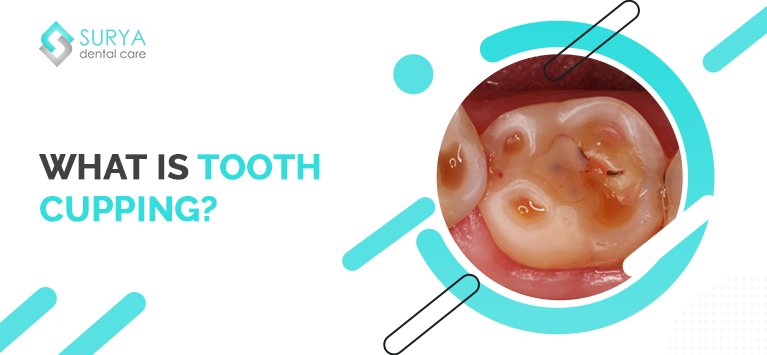
Dental erosion known as tooth cupping occurs when tiny cups or indentations appear on the chewing surfaces of your teeth. Although tooth cupping is a very uncommon type of erosion, it can be problematic because the enamel begins to deteriorate if the holes extend into the dentin, the tooth’s deep layer of hard tissue. This complicates the situation by making the cups deeper.
Despite being a kind of erosion, tooth cupping is not a cavity. But tooth cupping occurs when the enamel is worn down by plaque and germs, much like a cavity. Since enamel cannot be repaired after it has eroded, it is crucial to prevent tooth cupping and deal with it right away.
SYMPTOMS
Changes in your tooth’s texture and sensitivity are its two key signs. Your tongue may be able to detect tooth cupping, and you may even be able to see them.
As the enamel erodes, the margins of teeth with cupping may become uneven and the teeth may appear thinner than usual. Extreme tooth cupping can cause sensitivity to sweets and temperatures, as well as tooth discomfort or even infections.
Two types of enamel erosion can be used to focus on the common causes of tooth cupping:
Acids from gastric reflux or severe vomiting brought on by alcoholism or eating problems cause intrinsic erosion in the mouth.
Treatment for Tooth Cupping
There is no way for your enamel to “grow back,” which is the main issue with enamel erosion. Since enamel is not living tissue, it cannot be recovered once it has been lost.
Prevention
The best course of action is to prevent enamel erosion from starting in the first place because tooth enamel cannot be repaired. This include altering or removing specific items from your diet, practising proper oral hygiene, and avoiding behaviours that might erode your enamel.
1) Mouthguards
It is crucial to use a mouthguard to prevent tooth erosion if you have a propensity to grind your teeth. You might also look for methods to lessen tension and worry in
2) Dental Bonding
Your dentist can help you with tooth bonding if you’ve previously undergone considerable erosion. In tooth bonding, the injured tooth or teeth are covered with a sturdy, plastic chip that resembles a tooth.
This can prevent enamel loss on teeth with cupping, chips, cracks, and erosion. If your teeth have undergone discolouration or yellowing, tooth bonding can help balance out their colour.
3) Crowns and/or veneers
A dentist could advise veneers and/or crowns if you have extensive erosion. These are made of porcelain and are uniquely sculpted to match the shape, colour, and size of your mouth. In addition to protecting your damaged teeth, veneers and crowns will lessen some of your discomfort or sensitivity.
Bottom line
Along with following these suggestions, it’s critical to maintain proper dental hygiene practices including brushing your teeth and tongue, flossing, and mouthwash rinsing. This will hinder the growth of the bacteria which leads to tooth cupping and other types of dental erosion.



